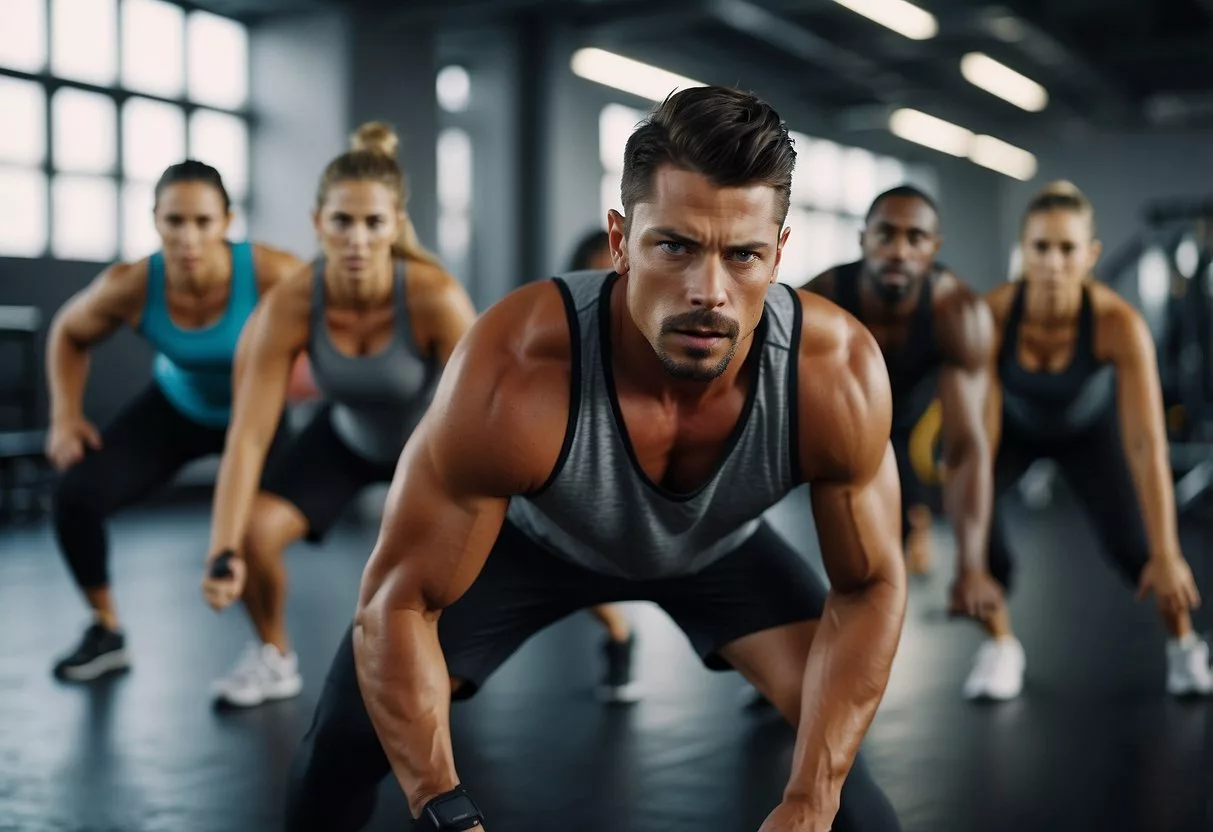High-Intensity Interval Training (HIIT) is a popular and effective workout method that combines short bursts of intense exercise with periods of rest. This allows people of various fitness levels to burn fat, build muscle, and improve cardiovascular health in a time-efficient manner. If you’re looking to maximize your workouts without spending hours at the gym, HIIT might be the perfect solution.

The beauty of HIIT lies in its adaptability. Whether you’re a beginner or an advanced athlete, you can tailor HIIT workouts to suit your needs. By varying the exercises and intensity levels, you can keep your workouts fresh and challenging. This flexibility makes HIIT accessible to anyone looking to enhance their fitness routine.
Additionally, HIIT provides significant health benefits beyond just physical fitness. Studies have shown that HIIT can improve metabolic health, reduce body fat, and even boost mental well-being. When compared to other forms of exercise, HIIT stands out for its ability to deliver results in a shorter amount of time, making it an attractive option for those with busy schedules.
Key Takeaways
- HIIT combines intense exercise with rest periods for maximum efficiency.
- It is adaptable for different fitness levels and goals.
- HIIT offers extensive health benefits, including improved metabolism and mental health.
Understanding HIIT

High-intensity interval training (HIIT) is known for its quick bursts of intense activity followed by rest periods. Its effectiveness contrasts with other training methods due to the specific structure of intensity and recovery.
Fundamentals of High-Intensity Interval Training
HIIT alternates between short, intense bursts of exercise and less intense recovery periods. This approach can include various activities such as running, cycling, or bodyweight exercises. Key elements are the high intensity during the work phase and the variability in the rest phase.
The intensity should be such that it pushes the individual near their limits. Recovery periods may involve complete rest or low-intensity activity.
Differences Between HIIT, SIT, and MICT
There are significant differences between HIIT, Sprint Interval Training (SIT), and Moderate Intensity Continuous Training (MICT). HIIT involves high effort followed by rest, SIT consists of all-out sprints with longer rest, and MICT includes continuous moderate effort without breaks.
- HIIT: Short bursts of high intensity, with varied rest.
- SIT: Maximum effort sprints, longer recovery.
- MICT: Steady moderate activity with no intervals.
These differences affect the effectiveness and suitability for different fitness goals and individual preferences.
HIIT Components: Workouts, Intensity, Duration, and Recovery
HIIT workouts can be highly varied involving cardio, weightlifting, or bodyweight exercises. The key is maintaining high intensity to maximize benefits.
- Intensity: Should be high enough to challenge the cardiovascular system.
- Duration: Typically 20-30 minutes but can vary.
- Recovery: Short and active, like lighter exercise or full rest, critical for effectiveness.
Workouts might include sprints, jumping exercises, or resistance training. Each component plays a role in achieving the health benefits associated with HIIT.
HIIT Techniques and Modalities

High Intensity Interval Training (HIIT) involves alternating between short bursts of intense activity and periods of rest or low-intensity exercise. This workout method can be applied in various ways, including cardio-based activities like cycling and running, as well as strength-focused exercises and structured protocols such as Tabata.
Common HIIT Exercises
HIIT exercises include a mix of cardio and strength movements designed to challenge different muscle groups. Common exercises are sprints, jump squats, and push-ups. These exercises help improve cardiovascular fitness and build muscle simultaneously. Burpees, mountain climbers, and kettlebell swings are also popular, requiring high energy output for short durations, followed by rest or low-intensity movements.
Cardio-Based HIIT: Cycling, Running, and Rowing
Cardio-based HIIT uses equipment like bikes, treadmills, and rowing machines. Cycling HIIT might involve 30 seconds of sprinting on a bike followed by a minute of slow pedaling. Running HIIT can include 30-second sprints with one-minute walking intervals. Rowing HIIT combines fast-paced rowing with slower recovery strokes. These methods target the cardiovascular system and improve endurance and calorie burning.
Strength-Focused HIIT and Circuit Training
Strength-focused HIIT incorporates weightlifting or bodyweight exercises. It often includes moves like deadlifts, bench presses, and pull-ups. Circuit training involves moving from one strength exercise to another with minimal rest. Combining these with cardio bursts, such as jump rope or sprints, creates a comprehensive workout that enhances both muscle strength and cardiovascular health.
Tabata and Other HIIT Protocols
Tabata is a well-known HIIT protocol involving 20 seconds of maximum effort followed by 10 seconds of rest, repeated for four minutes. This method can be applied to various exercises like squats, push-ups, and cycling. Other protocols include the 30-20-10 workout where participants alternate between 30 seconds of low intensity, 20 seconds of moderate intensity, and 10 seconds of high intensity. These structured methods offer variety and can be easily adapted for different fitness levels.
Physiological Impact of HIIT

High Intensity Interval Training (HIIT) involves short, intense bursts of exercise followed by recovery periods. This type of training has significant impacts on cardiovascular health, metabolism, muscle strength, and blood sugar levels.
Cardiovascular and Aerobic Benefits
HIIT can significantly improve cardiovascular health by increasing both heart rate and oxygen consumption. Exercising at near-maximal heart rates of 80-95% of one’s maximum heart rate enhances aerobic capacity. This allows the heart to pump more efficiently and increases the volume of blood that can be distributed to muscles. Regular HIIT sessions can also lead to lower resting heart rates, improved stroke volume, and enhanced endurance performance. Studies have shown that these effects are comparable to those achieved through traditional aerobic exercises such as running or cycling for longer durations.
Effects on Metabolic Rate and Energy Expenditure
One of the main advantages of HIIT is its effect on metabolic rate and energy expenditure. HIIT helps boost the metabolic rate not just during the workout but also after exercise, a phenomenon known as excess post-exercise oxygen consumption (EPOC). This post-exercise period increases the body’s energy expenditure, leading to more calories burned throughout the day. Research indicates that HIIT can burn 25-30% more calories compared to moderate-intensity endurance training within the same time frame. This makes HIIT an efficient way to enhance caloric burn and promote weight loss.
Muscle Adaptations and Strength Enhancement
HIIT also induces significant muscle adaptations and strength enhancements. Unlike steady-state cardio, HIIT incorporates high-intensity movements that can improve muscle hypertrophy and strength. Training at high intensities stimulates the production of muscle fibers, particularly type II fibers, which are essential for power and strength. This can lead to improved muscle tone and increased overall strength. Additionally, the varying intensity levels in HIIT workouts can help reduce the risk of muscle overuse injuries often associated with repetitive, long-duration forms of exercise.
Impact on Blood Sugar and Insulin Sensitivity
For individuals with conditions like diabetes, HIIT can be particularly beneficial for managing blood sugar levels and improving insulin sensitivity. By engaging in high-intensity exercise, glucose uptake in the muscles is enhanced, which lowers blood sugar levels. HIIT can also improve insulin sensitivity, making it easier for the body to use glucose more effectively. Research has found that these improvements can be significant even after just a few weeks of HIIT, making it a valuable exercise method for those seeking to manage or prevent diabetes.
Health and Fitness Outcomes

High Intensity Interval Training (HIIT) offers several benefits in terms of weight loss, reducing body fat, improving overall health, and optimizing physical activity.
Weight Loss and Body Fat Reduction
HIIT is effective for weight loss and reducing body fat. This is achieved through short bursts of intense exercise followed by rest or low-intensity exercise. The high intensity increases calorie burn during and after the workout.
Research shows that HIIT can lead to significant reductions in body fat. The workouts often involve exercises that target multiple muscle groups, such as sprints, cycling, or jumping exercises. This helps in burning more calories in a shorter time compared to traditional workouts.
A study noted that individuals engaging in HIIT three times per week saw a notable reduction in body fat over those doing moderate exercise.
Improvements in Overall Health
HIIT provides numerous health benefits. It enhances cardiovascular health by improving VO2 max, which is the maximum amount of oxygen the body can use during exercise. Better VO2 max is linked to lower risks of heart diseases and improved endurance.
HIIT also helps in managing blood pressure and blood sugar levels. For people with type 2 diabetes, HIIT can be more effective than moderate exercise in controlling blood sugar.
In addition to physical benefits, HIIT improves mental health by reducing stress and anxiety. Short, intense workouts can lead to the release of endorphins, the body’s natural feel-good hormones.
Optimizing Physical Activity Through HIIT
HIIT optimizes physical activity by efficiently utilizing short periods of high intensity. This approach fits well into busy schedules, making it an excellent option for those with limited time.
Each HIIT session can be customized to fit different fitness levels and goals. Beginners can start with shorter intervals and longer rest periods, gradually increasing intensity as they become fitter.
The varied nature of HIIT workouts helps in preventing boredom and keeps the exercises engaging. Different HIIT routines can include activities like running, cycling, swimming, or bodyweight exercises, making it a versatile training method for improving physical activity.
For more detailed information, you can refer to this research on exercise capacity, the benefits of HIIT for cardiovascular health, and how HIIT compares to moderate exercise.
Practical Considerations for HIIT

When planning High-Intensity Interval Training (HIIT), important factors include the necessary equipment and space, ensuring safety to prevent injuries, customizing workouts for beginners, and integrating HIIT with existing fitness routines.
Essential Equipment and Space Requirements
HIIT often requires minimal equipment. Basic essentials include a good pair of athletic shoes, a timer or stopwatch, and possibly a mat for floor exercises. Dumbbells, resistance bands, and kettlebells can add variety but are optional.
Adequate space is crucial. A clear, open area indoors or a flat outdoor spot works best. Ensure there is enough room to move freely without obstacles to reduce injury risk.
Injury Prevention and Safe Practice
Proper form is key to preventing injuries. It’s important to understand the correct way to perform each exercise. Watching instructional videos or working with a trainer can be helpful.
Warm-up before starting HIIT and cool down after the session. This prepares the muscles and joints for intense activity. Pay attention to body signals. If there is pain beyond normal exertion, it may be wise to stop and consult a professional.
Customization for Beginners and Different Fitness Levels
For those new to HIIT, start with shorter intervals and lower intensity. Beginners might begin with 15 seconds of high intensity followed by 45 seconds of rest. Gradually increase the intensity and duration as fitness improves.
Different fitness levels require different approaches. More experienced individuals can handle longer high-intensity periods and shorter rest times. Customization ensures the workout is challenging yet safe for everyone.
Integrating HIIT into an Existing Workout Regimen
HIIT can complement existing workout routines well. It’s effective to alternate HIIT days with strength training or lower intensity cardio. For example, one might do strength training on Monday, HIIT on Tuesday, and a lighter cardio session on Wednesday.
The key is balance. Allow time for recovery to avoid overtraining and burnout. Mixing different types of workouts can enhance overall fitness and keep the routine interesting.
Scientific and Expert Perspectives

High-Intensity Interval Training (HIIT) has gained substantial recognition for its health and performance benefits. This section delves into expert endorsements, research findings, and contemporary topics related to HIIT.
Endorsements by the American College of Sports Medicine
The American College of Sports Medicine (ACSM) strongly endorses HIIT due to its substantial benefits for cardiovascular health and overall fitness. ACSM highlights HIIT’s ability to improve VO2 max, an indicator of cardiovascular fitness. By engaging in high-intensity bursts followed by rest, individuals can achieve significant improvements in a shorter time.
ACSM’s guidelines describe how HIIT can help not only athletes but also general population. They emphasize its role in reducing body fat, increasing muscle endurance, and enhancing metabolic rate. The integration of HIIT in routine fitness regimens is encouraged as a time-efficient strategy for improving health and fitness.
Research Findings on HIIT’s Effectiveness
Research indicates that HIIT can be highly effective for improving aerobic and anaerobic capacities. A pivotal study by Izumi Tabata demonstrated that short bursts of high-intensity activity followed by brief rest periods significantly increased VO2 max.
Studies also show that HIIT can boost Excess Post-Exercise Oxygen Consumption (EPOC), meaning the body continues to burn calories after the workout. This effect contributes to weight loss and improved metabolic function. Additionally, evidence suggests that HIIT can enhance insulin sensitivity and reduce the risk of chronic diseases, making it a valuable component of fitness programs.
Contemporary Topics in HIIT Research
Contemporary research on HIIT explores various dimensions, including optimal workout durations and intensities. Studies investigate the minimum effective dose of HIIT to achieve benefits without overtraining. Researchers also examine how HIIT can be tailored for different populations, including older adults and those with chronic conditions.
Innovative HIIT protocols, such as those integrating strength training and flexibility exercises, are being tested for their comprehensive fitness benefits. Advances in sports science continually refine HIIT methodologies, aiming to maximize benefits while minimizing risks. The evolving understanding of HIIT underscores its versatility and effectiveness in diverse fitness contexts.
Advanced HIIT Concepts

Advanced HIIT techniques require careful attention to the work-to-rest ratio, effective utilization of excess post-exercise oxygen consumption (EPOC), and incorporating resistance training to enhance results. Here’s how to apply these concepts.
Work-to-Rest Ratio and Its Importance
The work-to-rest ratio in HIIT determines the intensity and effectiveness of the workout. In advanced HIIT, a common ratio is 2:1, such as sprinting for 30 seconds and resting for 15 seconds. This approach helps push the body’s limits while allowing brief recovery.
Different goals may require tweaks to this ratio. For endurance, a 1:1 ratio might be better. For maximum intensity, even shorter rest periods can be effective. Properly managing this ratio ensures that the body is sufficiently challenged and can recover just enough to continue performing.
Maximizing Afterburn with Excess Post-Exercise Oxygen Consumption (EPOC)
Excess post-exercise oxygen consumption (EPOC) is the increased rate of oxygen intake following strenuous activity. Advanced HIIT workouts can significantly boost EPOC, leading to more calories burned post-exercise. This “afterburn” effect helps in weight management and muscle recovery.
To maximize EPOC, include compound movements like burpees and kettlebell swings. These exercises engage multiple muscle groups, raising the heart rate and oxygen consumption. Incorporating intervals of maximal effort followed by short rest periods enhances EPOC more effectively than steady-state cardio.
High-Intensity Interval Resistance Training (HIRT)
High-Intensity Interval Resistance Training (HIRT) combines the principles of HIIT with resistance training. This method involves performing resistance exercises, such as squats or deadlifts, at high intensity with short rest periods. HIRT aims to build muscle and improve cardiovascular health simultaneously.
For effective HIRT, choose weights that are challenging but manageable. Sessions typically last 20-30 minutes, making them time-efficient. The integration of weight training into HIIT sessions helps increase overall strength and muscle mass, which can also boost metabolism.
By focusing on these advanced concepts, individuals can enhance their HIIT workouts, achieving better results in less time.
Adaptations and Variations of HIIT

High-Intensity Interval Training (HIIT) offers unique adaptations for different groups and can be modified for various environments. This versatility makes it accessible and effective for a wide range of individuals and settings.
Adaptations for Special Populations
HIIT can be tailored for special populations such as older adults, those with chronic diseases, and beginners. For seniors, shorter intervals and longer rest periods can reduce the risk of overexertion. Adjusting exercise intensity to individual fitness levels ensures safety while still providing benefits. In people with chronic conditions like heart disease, a customized HIIT program can improve cardiovascular health and aerobic capacity.
In novice exercisers, gradual progression in intensity and duration helps build endurance without causing injury. Modifying exercises to match personal fitness levels and health conditions is key. This could involve using lower-impact activities to lessen joint stress. For instance, brisk walking or cycling can replace running.
Incorporating HIIT in Non-Traditional Settings
HIIT is flexible enough to be performed in various non-traditional settings such as home, parks, or even workplaces. At home, bodyweight exercises like burpees, squats, and push-ups offer effective workouts without equipment. Creating a circuit of exercises with fixed intervals and rest periods keeps it simple and efficient.
In workplaces, short HIIT sessions can be integrated as quick breaks to boost energy and productivity. Utilizing office furniture for step-ups or tricep dips is practical. Parks provide space and natural resistance elements like hills for running intervals or benches for dynamic exercises.
These adaptations make HIIT accessible, reducing barriers related to location and equipment, thus promoting consistent participation in diverse environments.
Monitoring Progress and Results

Keeping track of your progress and results with High Intensity Interval Training (HIIT) is key to maximizing benefits and staying motivated. Different methods like tracking fitness improvements, body changes, and understanding heart rate data help provide a clear picture of advancements.
Tracking Fitness Improvements and Body Changes
Tracking fitness improvements can be done using several tools, such as fitness apps, progress photos, and measurements. Fitness apps can log workouts, showing how workout intensity and duration change over time. Taking progress photos every few weeks provides a visual representation of body changes, highlighting differences in muscle tone and body composition.
Body measurements such as waist, hip, and thigh circumferences can offer additional data on changes. Recording weight and body fat percentage can also provide insights into how effective HIIT is for achieving fitness goals. Keeping a workout journal where specific exercises, repetitions, and sets are noted can help identify improvements in strength and endurance.
Understanding and Utilizing Heart Rate Data
Heart rate data is vital for monitoring progress in HIIT. Understanding this data helps in optimizing workout intensity and tracking cardiovascular health. Using a heart rate monitor, users can track their max heart rate, which is crucial for pushing limits safely. Knowing the resting heart rate can give insights into overall fitness; a lower resting heart rate often indicates improved cardiovascular health.
Target heart rate zones ensure that exercises are performed at the correct intensity. By staying within these zones during workouts, one can maximize cardiovascular benefits and efficiency. Post-workout heart rate recovery is another indicator of fitness improvements. Faster recovery times typically suggest better cardiovascular conditioning and overall progress.
By paying attention to these metrics, individuals can tailor their HIIT programs to fit their fitness levels and goals precisely.
Frequently Asked Questions

High Intensity Interval Training (HIIT) provides numerous benefits, including improved cardiovascular health and efficient workouts. It can be done at home with minimal equipment, shaping effective routines for beginners and advanced athletes alike.
What are the core benefits of High Intensity Interval Training?
HIIT workouts are known for their efficiency. They can improve cardiovascular health, increase stamina, and burn calories rapidly. These exercises often lead to better aerobic and anaerobic fitness levels. For example, this study shows that HIIT can improve oxygen flow in the body.
How can I perform High Intensity Interval Training at home?
HIIT can be done at home with little or no equipment. Simple exercises include jumping jacks, burpees, and push-ups. Following a routine like Tabata Training can also be effective. This involves 20 seconds of high-intensity effort followed by 10 seconds of rest, repeated for four minutes.
What does a beginner’s High Intensity Interval Training routine involve?
A beginner’s routine typically includes 5-10 basic exercises. Each exercise might last for 30 seconds, with a short rest in between. Total workout time can be around 15-20 minutes. This guide suggests starting with basic movements such as squats, lunges, and simple cardio moves.
Can running be effectively incorporated into High Intensity Interval Training?
Yes, running can be a key part of HIIT. It usually involves short bursts of sprinting followed by walking or jogging. This variation in intensity helps to boost cardiovascular benefits and endurance. For example, sprint intervals are a common technique.
How much High Intensity Interval Training is recommended for weight loss?
For weight loss, HIIT is recommended 2-3 times per week. This frequency helps maintain a high metabolic rate and promotes fat burning. Each session should be designed to maximize calorie expenditure without overtraining.
What should be the duration and frequency of High Intensity Interval Training sessions for optimal results?
For optimal results, HIIT sessions should last between 20-30 minutes and be performed 2-4 times a week. Keeping workouts within this time frame ensures that the high-intensity efforts are sustainable and effective over the long term. This structure helps the body to recover properly between sessions while still promoting impressive fitness gains.